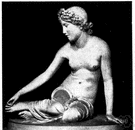The perfect case in point is the season's top lot, Ludovico Carracci's splendid
Salmacis and Hermaphroditus (Fig.
The influence of the story of
Salmacis and Hermaphroditus on this has often been remarked and in Golding where
Salmacis `hides' in the bushes IV.418) while the boy `stripped quight / His garments from his tender skin' to enter her pool (425-6), in an episode in which the wanton nymph `alwayes hath hir eye on him' (419), the `sedge' is the first plant referred to when her pool is described.(4)
More untouched canvases are unveiled in Christie's paintings sale on 6 July, not least another rediscovery: Ludovico Carracci's unlined
Salmacis and Hermaphroditus from Knole in Kent, where it may well have been since the 17th century.
Hermaphroditus was born "in the image" of both his mother and father and is always (to a degree) already the hermaphrodite he becomes subsequent to his encounter with
Salmacis.
Thus the polypus or octopus with its tentacles in the celebrated simile describing the struggle between
Salmacis and Hermaphroditus (~Polypus ...
The fate of a newly identified
Salmacis and Aphrodite by Lodovico Carracci (1555-1619) hangs in the balance.
He writes, "Beneath the woman's and the water's kiss / Thy moist limbs melted into
Salmacis, / And the large light turned tender in thine eyes, / And all thy boy's breath softened into sighs" (Poems 52-5).
Among the topics are
Salmacis, Hermaphrodite, and the inversion of gender: allegorical interpretations and pictorial representations of an Ovidian myth; lamenting, dancing, praising: the multilayered presence of nymphs in Florentine elegiac poetry of the Quattrocento; Renaissance nymphs as intermediaries in early modern German territorial politics; the medialilty of the nymph in the cultured context of Pirro Visconti's villa at Lainate; and our white ladies on the graves: historicizations of nymphs in early modern antiquarianism.
While Rodin's models were indeed "two priestesses of the isle of Lesbos," Rodin explained to the important Danish collector and Carlsberg beer magnate Carl Jacobsen in 1907 that the particular Ovidian metamorphosis he really had in mind and tried to capture in his title was the tale directly following that of Daphnis and Chloe in Book IV of The Metamorphoses: the tale of the water nymph
Salmacis, who falls in love with the boy Hermaphroditus (Le Normand-Romain 74).
The term "hermaphrodite" is derived from Greek mythological God "Hermaphroditus", son of Hermes and Aphrodite, whose body after being merged with nymph
Salmacis assumed a more perfect form with both male and female attributes.
El mito ovidiano cuenta la historia de Hermafrodito, quien no conoce el amor y se ve perseguido por
Salmacis, por lo que se sumerge en aguas transparentes, de las que emergen ambos cuerpos fusionados en medio hombre.
 Salmacis - nymph who merged with Hermaphroditus to form one body
Salmacis - nymph who merged with Hermaphroditus to form one body